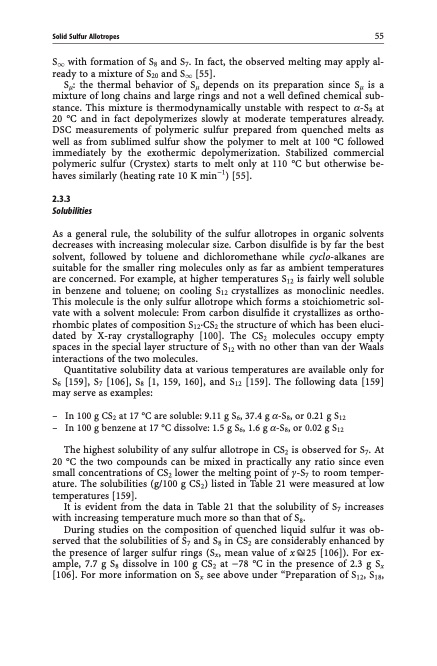
PDF Publication Title:
Text from PDF Page: 065
Solid Sulfur Allotropes 55 S1 with formation of S8 and S7. In fact, the observed melting may apply al- ready to a mixture of S20 and S1 [55]. Sm: the thermal behavior of Sm depends on its preparation since Sm is a mixture of long chains and large rings and not a well defined chemical sub- stance. This mixture is thermodynamically unstable with respect to a-S8 at 20 C and in fact depolymerizes slowly at moderate temperatures already. DSC measurements of polymeric sulfur prepared from quenched melts as well as from sublimed sulfur show the polymer to melt at 100 C followed immediately by the exothermic depolymerization. Stabilized commercial polymeric sulfur (Crystex) starts to melt only at 110 C but otherwise be- haves similarly (heating rate 10 K min1) [55]. 2.3.3 Solubilities As a general rule, the solubility of the sulfur allotropes in organic solvents decreases with increasing molecular size. Carbon disulfide is by far the best solvent, followed by toluene and dichloromethane while cyclo-alkanes are suitable for the smaller ring molecules only as far as ambient temperatures are concerned. For example, at higher temperatures S12 is fairly well soluble in benzene and toluene; on cooling S12 crystallizes as monoclinic needles. This molecule is the only sulfur allotrope which forms a stoichiometric sol- vate with a solvent molecule: From carbon disulfide it crystallizes as ortho- rhombic plates of composition S12·CS2 the structure of which has been eluci- dated by X-ray crystallography [100]. The CS2 molecules occupy empty spaces in the special layer structure of S12 with no other than van der Waals interactions of the two molecules. Quantitative solubility data at various temperatures are available only for S6 [159], S7 [106], S8 [1, 159, 160], and S12 [159]. The following data [159] may serve as examples: – In100gCS2 at17Caresoluble:9.11gS6,37.4ga-S8,or0.21gS12 – In 100 g benzene at 17 C dissolve: 1.5 g S6, 1.6 g a-S8, or 0.02 g S12 The highest solubility of any sulfur allotrope in CS2 is observed for S7. At 20 C the two compounds can be mixed in practically any ratio since even small concentrations of CS2 lower the melting point of g-S7 to room temper- ature. The solubilities (g/100 g CS2) listed in Table 21 were measured at low temperatures [159]. It is evident from the data in Table 21 that the solubility of S7 increases with increasing temperature much more so than that of S8. During studies on the composition of quenched liquid sulfur it was ob- served that the solubilities of S7 and S8 in CS2 are considerably enhanced by the presence of larger sulfur rings (Sx, mean value of x 25 [106]). For ex- ample, 7.7 g S8 dissolve in 100 g CS2 at 78 C in the presence of 2.3 g Sx [106]. For more information on Sx see above under “Preparation of S12, S18,PDF Image | Topics in Current Chemistry

PDF Search Title:
Topics in Current ChemistryOriginal File Name Searched:
Elemental-Sulfur-und-Sulfur-Rich-Compounds-I.pdfDIY PDF Search: Google It | Yahoo | Bing
Sulfur Deposition on Carbon Nanofibers using Supercritical CO2 Sulfur Deposition on Carbon Nanofibers using Supercritical CO2. Gamma sulfur also known as mother of pearl sulfur and nacreous sulfur... More Info
CO2 Organic Rankine Cycle Experimenter Platform The supercritical CO2 phase change system is both a heat pump and organic rankine cycle which can be used for those purposes and as a supercritical extractor for advanced subcritical and supercritical extraction technology. Uses include producing nanoparticles, precious metal CO2 extraction, lithium battery recycling, and other applications... More Info
| CONTACT TEL: 608-238-6001 Email: greg@infinityturbine.com | RSS | AMP |